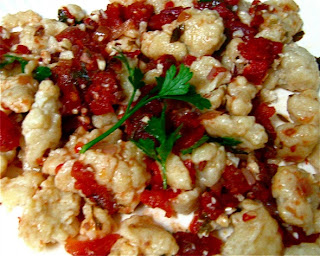
I'm not sure if that's actually what I meant to write or if it's just tactile stuttering because I can barely feel my fingers...
It was a long bike ride from Jean-Talon this morning and the Tunisian dates and the bison rib didn't keep me warm from the inside out as I'd hoped. I did the same thing last Sunday minus the rib but it really didn't seem as cold then. Last week I loaded my bike up with a mix of red and green peppers and planned to do some standard pickling. So far my pickling has been a bit exotic for a newbie (fig jam, cayenne peppers, green gage plum and vanilla jam, daikon radish threads with Sichuan peppercorns) so I decided to step back and try a basic recipe for pickled peppers. Now I'm sure they weren't already pickled when Peter Piper picked them. In fact he probably brought them home to his mother or wife to pickle them, but he put the effort in. My equivalent effort was getting the pickles home from the market. Not one spilled (unlike my heart-breaking blueberries) but I had no wife or mother at home to pickle them for me. I'll think about working on that.
Pickled Peppers
8 green peppers. sliced
8 red peppers, sliced
8 medium onions, roughly diced
2 cups white vinegar
2 cups sugar
2 tsp salt
In the end I don't think I like this recipe because in all the blanching and boiling the peppers lose their colour, which means they lose a lot of their nutrients, and that's kind of the whole point of canning - to preserve things such as nutrients. Still, it was the best recipe I could find, having not looked particularly hard in three recipe books and not trusting the internet.
Let it be known, I did this all correctly:
1. Wash your jars, lids and canning rings in hot soapy water and put the jars and rings in a big stock pot or canning pot. Bring the pot to a boil and boil for 20 minutes. After 20 minutes, just leave the jars and rings in the water but turn off the heat.
2. Combine the peppers, onions and 1 1/2 cups of boiling water in a large saucepan. Cover the pan and let it stand for 5 minutes. Drain.
3. Return the vegetables to the saucepan. Stir in 2/3 cup vinegar and 2/3 cup water. Bring to a boil, reduce heat, and simmer for 5 minutes.
4. Drain the vegetables again and put them back in the saucepan. Cry a little as all those nutritious things circle down the drain. Dream of summer when all this canning nonsense isn't necessary.
5. In a small saucepan, bring a cup of water to a boil, then turn off the heat and add the jar lids. You don't want to boil them and wreck the wax seal.
6. Heat the remaining 1 1/3 vinegar, the sugar and the salt in a microwavable bowl or cup (or on the stove in a saucepan, but that makes your stove pretty busy). Add the mixture to the vegetables and again boil the heck out of the previously brightly coloured peppers. Okay, well boil them gently for about 25 minutes, until they're tender-crisp.
7. Carefully take the jars out of the sterilizing water (for some method suggestions, check here) and place on a clean cloth next to the pepper pot.
8. Fill the jars with peppers, onions, and brine up to a 1/2 inch from the rim of the jars. Use a chopstick or spatula to push down to get any air bubbles out, and then wipe the rims down with a clean cloth or paper towel. Carefully place the lids on top, then the tightening rings (no hands, please). You can tighten the rings by hand, though. Not too, too tight. Not superman tight. Just "little old lady" tight. Harness your inner little old lady. Do not:
1. Swear when you drop a lid
2. Cry when you see that's it's snowing
3. Give up. Never give up.
Then stick the jars back in the still hot sterilizing water (they shouldn't touch the sides or bottom of the pot, so put down a kitchen cloth in the bottom or form some kind of rack. Anyone want to patent a circular canning rack with me? Bring to a boil, and start the timer for 10 minutes (for half pints) or 20 minutes (for full pints) once the water comes to a boil again. Remove the jars again to a clean cloth, turn them upside down (not really necessary apparently, but it's comforting when they pop. Somehow makes botulism less scary) and let them cool. Label them. Now you're allowed to cry.
Hey, at least you have pickled peppers.









































